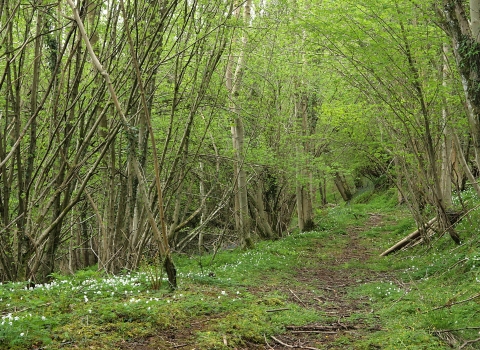
Chris Jones
New Grove Meadows
Know before you go
Dogs
When to visit
Amseroedd agor
Open at all timesAmser gorau i ymweld
All yearAm dan y warchodfa
With superb views across the lowlands to the looming mountains of Skirrid Fawr and Sugar Loaf, this reserve is a showcase of the beauty and diversity of plants to be found in traditionally-managed hay meadows. So rich is the diversity of wildflowers here that part of the site was selected as Monmouthshire’s ‘Coronation Meadow’ in 2013, part of a national scheme to celebrate wildflower meadows in the UK.
In spring and summer, the meadows are full of the dazzling yellows, pinks and purples of wildflowers like cowslips, common knapweed and five species of orchids, including spectacular displays of green-winged and common spotted-orchids. The mature hedgerows bordering the meadows provide food and shelter for many species of insects, birds and mammals, including hazel dormice. In autumn, wildflowers are replaced by an impressive array of fungi. The reserve nurtures many weird and wonderful species but the waxcaps are the real treat. With wonderfully evocative names such as the butter waxcap, snowy waxcap and vermillion waxcap, this group of fungi comes in almost every colour imaginable.
What we do here
We follow the traditional management practices that have made these meadows so special for wildflowers. After a late-summer hay cut, our small flock of Hebridian sheep graze the meadows during autumn and winter. Known as ‘aftermath grazing’, they play a very important role in controlling the growth of more vigorous plants and grasses that might overwhelm the site, whilst trampling the wildflower seeds into the soil to help them germinate the following year.
After discovering the presence of dormice and harvest mice in the meadows, we have planted strips of scrub to increase their habitat.
Directions
By car
From Monmouth, go south on the B4293 (signposted ‘Trellech’ and ‘Mitchel Troy’). About 1.5m from Monmouth, take the left fork (signposted ‘Trellech’ and ‘Chepstow’). Continue uphill along the B4293, following signs towards ‘Trellech/Trellek’. Just under 1km after passing the turn off to ‘The Narth’ and ‘Whitebrook’, you will see a turning on the right marked with a sign for ‘Wet Meadow’. Take this turning and a short distance down the track, to the right of the crossroads is a forestry car park where you can park (grid ref SO 500 066).
Walk back along the track towards the road and the reserve entrance is on your left.
Near the reserve
Gwent Wildlife Trust’s Croes Robert Wood reserve can be reached on foot through the plantations to the west of New Grove Meadows. Margaret’s Wood, Pentwyn Farm, Wyeswood Common and Prisk Wood reserves are all just a short drive away.
There is much historical interest in the surrounding area, with the picturesque village of Trellech, once a bustling Welsh town in the 13th Century, just down the road. Three standing stones, known locally as ‘Harold’s Stones’, are thought to have played a role in religious ceremonies.


